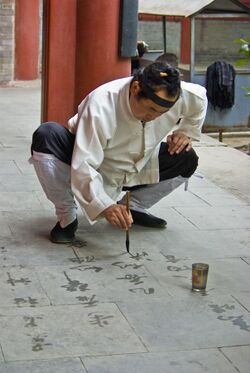Taoist priest
Topic: Religion
 From HandWiki - Reading time: 2 min
From HandWiki - Reading time: 2 min

A Taoist priest, Taoist monk, Taoist master or Professional Taoist (道士 "master of the Tao") is a priest in Taoism. Some orders are monastic (Quanzhen orders), while the majority are not (Zhengyi orders).
Some of the monastic orders are hermitic, and their members practice seclusion and ascetic lifestyles in the mountains, with the aim of becoming xian, or immortal beings. Non-monastic priests live among the populace and manage and serve their own temples or popular temples.
The activities of the Taoists tend to be informed by materials which may be found in the Daozang, or Daoist Canon; however, Taoists generally choose, or inherit, specific texts which have been passed down for generations from teacher to student, rather than consulting published versions of these works.
Orders
Taoist orders are conventionally categorised into two main branches: Quanzhen and Zhengyi.
Quanzhen Taoism
Quanzhen Taoism, which is present almost exclusively in the north of China , includes all Taoist orders which have a monastic institution. Their lifestyle is comparable to that of the Buddhist monks in that they are celibate, vegetarian, and live in monasteries. The White Cloud Temple in Beijing is the main monastery of the Longmen school of Quanzhen, and is also the main headquarters of mainland China's official Taoist Church.
Zhengyi Taoism
The other main priesthood is Zhengyi Taoism, in which the priests can marry, eat meat, live in their own homes, and found and manage their own temples or serve in folk religious temples. They are mostly priests part-time and can hold other jobs. Their lineages are transmitted through training and ordination by another priest, although historically they received a formal confirmation in their role by the Celestial Master, the highest priest. Fragmentation of the lineage of the Celestial Masters has made Zhengyi priests more independent. In mainland China the Taoist Church has in theory taken over the power to regulate them (although only a minority of them are registered with the Church). Zhengyi orders are present all over China, although with different names according to the local lineages. For example, in northern China there are the yinyang masters of the Lingbao sub-tradition.[1]
References
- ↑ Jones, 2007. p. 5
Sources
- Jones, Stephen. 2007. Ritual and Music of North China: Shawm Bands in Shanxi. Ashgate. ISBN:0754661636
See also
- Altar
- Taoism
- Han Chinese clothing
- Li Bai
- Sifu
 KSF
KSF
